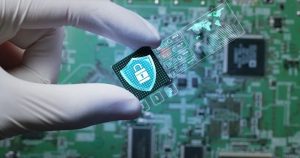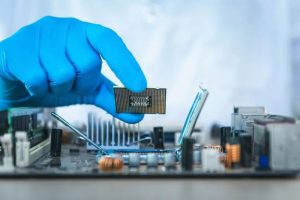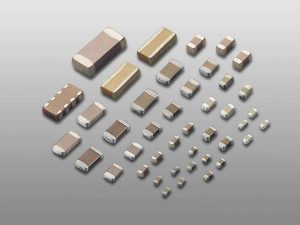“Discover the diversity: Over 5 types of integrated circuits shaping our tech world!”
Introduzione
Integrated circuits (ICs) are fundamental components in modern electronics, and they come in various types based on their functionality, complexity, and application. Broadly, ICs can be categorized into several types: Analog ICs, which process continuous signals and include operational amplifiers and voltage regulators; Digital ICs, which handle discrete signals and encompass microprocessors, microcontrollers, and memory chips; Mixed-Signal ICs, which combine both analog and digital functions; and Radio Frequency ICs (RFICs), designed for high-frequency applications such as wireless communication. Additionally, ICs can be classified by their scale of integration, ranging from Small-Scale Integration (SSI) to Very-Large-Scale Integration (VLSI), reflecting the number of transistors they contain. Each type of IC plays a crucial role in the diverse landscape of electronic devices and systems.

Overview Of Different Types Of Integrated Circuits
Integrated circuits (ICs) are the cornerstone of modern electronics, playing a pivotal role in the functionality of countless devices. These tiny, complex assemblies of electronic components have revolutionized the way we design and use technology. Understanding the different types of integrated circuits is essential for anyone involved in electronics, whether as a hobbyist, student, or professional. There are several types of integrated circuits, each serving distinct purposes and applications.
Firstly, digital integrated circuits are among the most common types. These ICs operate using binary logic, where signals are represented by two distinct levels: high (1) and low (0). Digital ICs are fundamental in computing and digital communication systems. They include microprocessors, microcontrollers, memory chips, and logic gates. Microprocessors, for instance, are the brains of computers and many other devices, executing instructions and performing calculations. Microcontrollers, on the other hand, are used in embedded systems to control specific functions within a device.
Transitioning to another significant category, analog integrated circuits handle continuous signals, unlike their digital counterparts. These ICs are crucial in applications where signal processing is required, such as audio and radio frequency (RF) systems. Operational amplifiers (op-amps) are a prime example of analog ICs, used in a variety of signal conditioning, filtering, and amplification tasks. Analog ICs also include voltage regulators, which ensure that electronic devices receive a stable power supply, and analog-to-digital converters (ADCs), which convert analog signals into digital data for processing by digital systems.
In addition to digital and analog ICs, there are mixed-signal integrated circuits, which combine both analog and digital functions on a single chip. These ICs are particularly useful in applications that require both types of signal processing, such as in communication systems and complex sensor interfaces. Mixed-signal ICs can include components like digital-to-analog converters (DACs), which convert digital data back into analog signals, and phase-locked loops (PLLs), which are used in frequency synthesis and clock generation.
Furthermore, power integrated circuits are designed to manage and control the distribution of electrical power within a system. These ICs are essential in power management applications, including voltage regulation, power conversion, and battery management. Power ICs can be found in a wide range of devices, from portable electronics to industrial machinery, ensuring efficient and reliable power delivery.
Another noteworthy type of integrated circuit is the application-specific integrated circuit (ASIC). As the name suggests, ASICs are custom-designed for a particular application or function. These ICs offer optimized performance and efficiency for their intended use, making them ideal for specialized tasks in fields such as telecommunications, automotive systems, and consumer electronics. The design and production of ASICs can be costly and time-consuming, but the benefits of tailored functionality often outweigh these challenges.
Lastly, field-programmable gate arrays (FPGAs) represent a unique category of integrated circuits that can be reprogrammed after manufacturing. FPGAs offer flexibility and adaptability, allowing designers to modify the functionality of the IC to suit different applications or to update the design as requirements change. This reconfigurability makes FPGAs valuable in prototyping, research, and applications where adaptability is crucial.
In conclusion, the world of integrated circuits is diverse and multifaceted, encompassing a wide range of types that cater to various applications and requirements. From digital and analog ICs to mixed-signal, power, ASICs, and FPGAs, each type of integrated circuit plays a vital role in the advancement of technology. Understanding these different types helps us appreciate the complexity and ingenuity behind the electronic devices that shape our modern world.

Classification Of Integrated Circuits Based On Functionality
Integrated circuits (ICs) have revolutionized the world of electronics, enabling the development of compact, efficient, and powerful devices. These tiny marvels of engineering come in various types, each designed to perform specific functions. When classifying integrated circuits based on functionality, it is essential to understand the diverse roles they play in electronic systems. This classification helps in identifying the right type of IC for a particular application, ensuring optimal performance and efficiency.
One of the primary categories of integrated circuits based on functionality is analog ICs. These circuits process continuous signals and are essential in applications where signal amplification, filtering, or modulation is required. Analog ICs include operational amplifiers, voltage regulators, and analog multipliers. Operational amplifiers, for instance, are widely used in signal conditioning, filtering, and mathematical operations. Voltage regulators, on the other hand, ensure a stable output voltage, which is crucial for the proper functioning of electronic devices.
In contrast to analog ICs, digital ICs handle discrete signals, representing binary data. These circuits are the backbone of modern computing and digital communication systems. Digital ICs encompass a wide range of components, including logic gates, flip-flops, counters, and microprocessors. Logic gates are the fundamental building blocks of digital circuits, performing basic logical operations such as AND, OR, and NOT. Flip-flops are used for data storage and synchronization, while counters are essential in applications requiring counting and timing functions. Microprocessors, the heart of computers and many other digital devices, execute complex instructions and perform arithmetic and logical operations.
Another significant category is mixed-signal ICs, which combine both analog and digital functionalities on a single chip. These circuits are indispensable in applications requiring the conversion of analog signals to digital form and vice versa. Mixed-signal ICs include analog-to-digital converters (ADCs) and digital-to-analog converters (DACs). ADCs convert continuous analog signals into discrete digital values, enabling digital systems to process real-world signals. Conversely, DACs transform digital data into analog signals, which can be used to drive speakers, displays, and other analog devices.
Power management ICs (PMICs) represent another crucial classification based on functionality. These circuits are designed to manage the power requirements of electronic systems, ensuring efficient power distribution and consumption. PMICs include components such as battery management ICs, voltage regulators, and power switches. Battery management ICs monitor and control the charging and discharging of batteries, prolonging their lifespan and ensuring safe operation. Voltage regulators, as mentioned earlier, provide stable output voltages, while power switches control the distribution of power to various parts of a system.
Furthermore, there are application-specific integrated circuits (ASICs), which are custom-designed for particular applications. These ICs are tailored to meet the specific requirements of a given task, offering optimized performance and efficiency. ASICs are commonly used in industries such as telecommunications, automotive, and consumer electronics, where specialized functions are needed.
In addition to these categories, there are programmable ICs, such as field-programmable gate arrays (FPGAs) and programmable logic devices (PLDs). These circuits can be configured by the user to perform a wide range of functions, providing flexibility and adaptability in electronic design. FPGAs, for example, are used in applications requiring rapid prototyping and custom hardware solutions.
In conclusion, the classification of integrated circuits based on functionality reveals the diverse roles these components play in modern electronics. From analog and digital ICs to mixed-signal, power management, application-specific, and programmable ICs, each type serves a unique purpose, contributing to the advancement of technology and the development of innovative electronic systems. Understanding these classifications is essential for selecting the right IC for a given application, ensuring optimal performance and efficiency.
Types Of Integrated Circuits In Modern Electronics
Integrated circuits (ICs) are the cornerstone of modern electronics, playing a pivotal role in the functionality of countless devices. These tiny, complex assemblies of electronic components have revolutionized the way we design and use technology. To understand the breadth of their applications, it is essential to explore the various types of integrated circuits that exist today. Each type serves a unique purpose, contributing to the diverse landscape of modern electronics.
Firstly, digital integrated circuits are among the most prevalent types. These ICs process binary information, making them indispensable in computing and digital communication. They include microprocessors, which are the brains of computers, and memory chips, which store data. Digital ICs also encompass logic gates, flip-flops, and counters, all of which are fundamental in creating complex digital systems. Their ability to perform high-speed calculations and data processing has made them a cornerstone in the development of computers, smartphones, and other digital devices.
In contrast, analog integrated circuits handle continuous signals, making them crucial for applications that require signal amplification, filtering, and modulation. Operational amplifiers (op-amps) are a common type of analog IC, used extensively in audio equipment, sensors, and instrumentation. Analog ICs also include voltage regulators, which ensure stable power supply levels, and analog-to-digital converters (ADCs), which translate analog signals into digital data. These components are vital in bridging the gap between the analog world and digital systems, enabling seamless integration of various technologies.
Moreover, mixed-signal integrated circuits combine both digital and analog functionalities within a single chip. This hybrid approach allows for more efficient and compact designs, particularly in applications like telecommunications, where both types of signals are prevalent. Mixed-signal ICs are found in devices such as smartphones, where they manage tasks like audio processing, signal conversion, and power management. Their versatility and efficiency make them a popular choice in modern electronic design.
Another significant category is radio-frequency (RF) integrated circuits, which operate at high frequencies and are essential for wireless communication. These ICs are used in devices like mobile phones, Wi-Fi routers, and satellite communication systems. RF ICs include components such as amplifiers, mixers, and oscillators, which are designed to handle the unique challenges of high-frequency signal processing. Their ability to transmit and receive signals over long distances has been instrumental in the proliferation of wireless technology.
Furthermore, application-specific integrated circuits (ASICs) are tailored for particular applications, offering optimized performance for specific tasks. Unlike general-purpose ICs, ASICs are custom-designed to meet the exact requirements of a particular application, resulting in higher efficiency and performance. They are commonly used in industries such as automotive, aerospace, and consumer electronics, where specialized functions are necessary. The development of ASICs has enabled the creation of highly efficient and compact devices, tailored to meet the demands of specific applications.
Lastly, programmable integrated circuits, such as field-programmable gate arrays (FPGAs), offer flexibility by allowing users to configure the ICs according to their needs. FPGAs are widely used in prototyping, research, and applications where adaptability is crucial. They provide a platform for testing and developing new technologies without the need for custom manufacturing, making them invaluable in the fast-paced world of electronics innovation.
In conclusion, the diverse types of integrated circuits in modern electronics each play a vital role in the functionality and advancement of technology. From digital and analog ICs to mixed-signal, RF, ASICs, and programmable ICs, each type brings unique capabilities and benefits. Understanding these various types helps us appreciate the complexity and ingenuity behind the electronic devices that have become integral to our daily lives.

Exploring The Various Categories Of Integrated Circuits
Integrated circuits (ICs) have revolutionized the world of electronics, enabling the development of compact, efficient, and powerful devices. These tiny marvels of engineering come in various types, each designed to perform specific functions. Understanding the different categories of integrated circuits is essential for anyone involved in electronics, whether as a hobbyist, student, or professional.
To begin with, integrated circuits can be broadly classified into two main categories: analog and digital. Analog ICs process continuous signals and are used in applications such as amplifiers, oscillators, and voltage regulators. These circuits are crucial in converting real-world signals, like sound and light, into a form that can be processed by electronic devices. On the other hand, digital ICs handle discrete signals, representing data in binary form. They are the backbone of modern computing, found in microprocessors, memory chips, and digital signal processors.
Transitioning from these broad categories, we delve deeper into more specific types of integrated circuits. One prominent type is the microcontroller, a compact IC that integrates a processor, memory, and input/output peripherals on a single chip. Microcontrollers are ubiquitous in embedded systems, powering everything from household appliances to automotive electronics. Their versatility and efficiency make them indispensable in modern technology.
Another significant category is the application-specific integrated circuit (ASIC). As the name suggests, ASICs are custom-designed for a particular application, offering optimized performance and efficiency. These ICs are commonly used in high-volume products like smartphones, where tailored functionality can provide a competitive edge. The design process for ASICs is complex and costly, but the benefits in terms of performance and power consumption often justify the investment.
Field-programmable gate arrays (FPGAs) represent another fascinating type of integrated circuit. Unlike ASICs, FPGAs are reconfigurable, allowing designers to modify the circuit’s functionality even after manufacturing. This flexibility makes FPGAs ideal for prototyping and applications where adaptability is crucial. They are widely used in telecommunications, aerospace, and defense industries, where the ability to update and reprogram hardware can be a significant advantage.
Memory ICs form another essential category, encompassing various types such as RAM, ROM, and flash memory. These circuits are vital for storing data and instructions in electronic devices. RAM (Random Access Memory) is used for temporary data storage, providing the fast access needed for active processes. ROM (Read-Only Memory) stores firmware and other permanent data, while flash memory offers non-volatile storage that can be electrically erased and reprogrammed, making it ideal for applications like USB drives and solid-state drives.
Power management ICs (PMICs) are also crucial, ensuring that electronic devices operate efficiently by managing power distribution and consumption. These ICs include voltage regulators, battery management systems, and power converters, playing a vital role in extending battery life and improving energy efficiency in portable devices.
In addition to these categories, there are mixed-signal ICs that combine analog and digital functions on a single chip. These circuits are essential in applications like data converters, where analog signals need to be converted to digital form and vice versa. Mixed-signal ICs are found in a wide range of devices, from audio equipment to communication systems.
In conclusion, the world of integrated circuits is vast and varied, with each type serving a unique purpose in the realm of electronics. From analog and digital ICs to microcontrollers, ASICs, FPGAs, memory ICs, power management ICs, and mixed-signal ICs, these components are the building blocks of modern technology. Understanding their differences and applications provides valuable insight into the intricate workings of the electronic devices that shape our daily lives.
Conclusione
There are several types of integrated circuits, including analog ICs, digital ICs, and mixed-signal ICs. Analog ICs process continuous signals, digital ICs handle discrete signals, and mixed-signal ICs combine both analog and digital functions. Additionally, ICs can be categorized based on their complexity and functionality, such as microprocessors, memory chips, and application-specific integrated circuits (ASICs).
